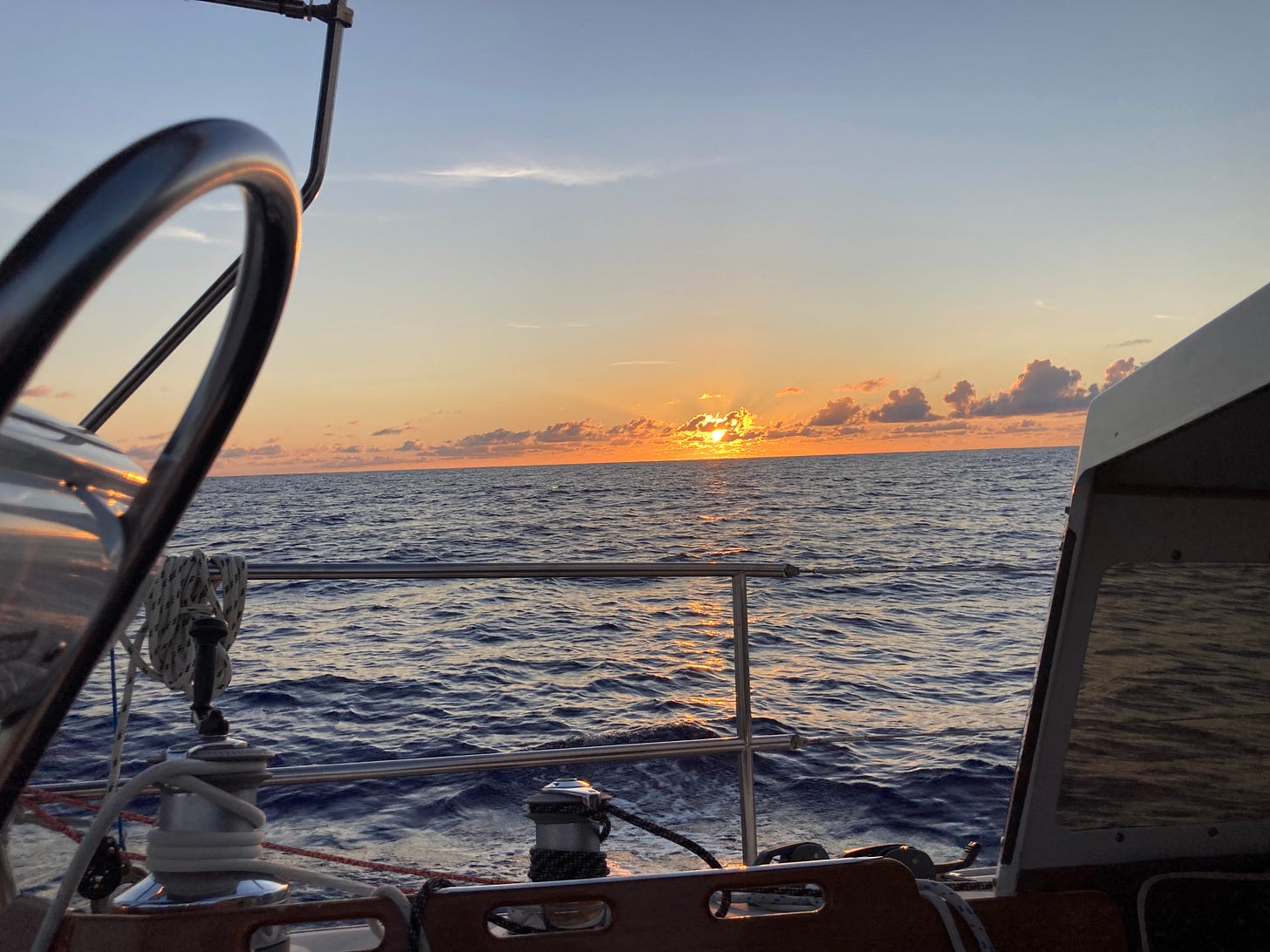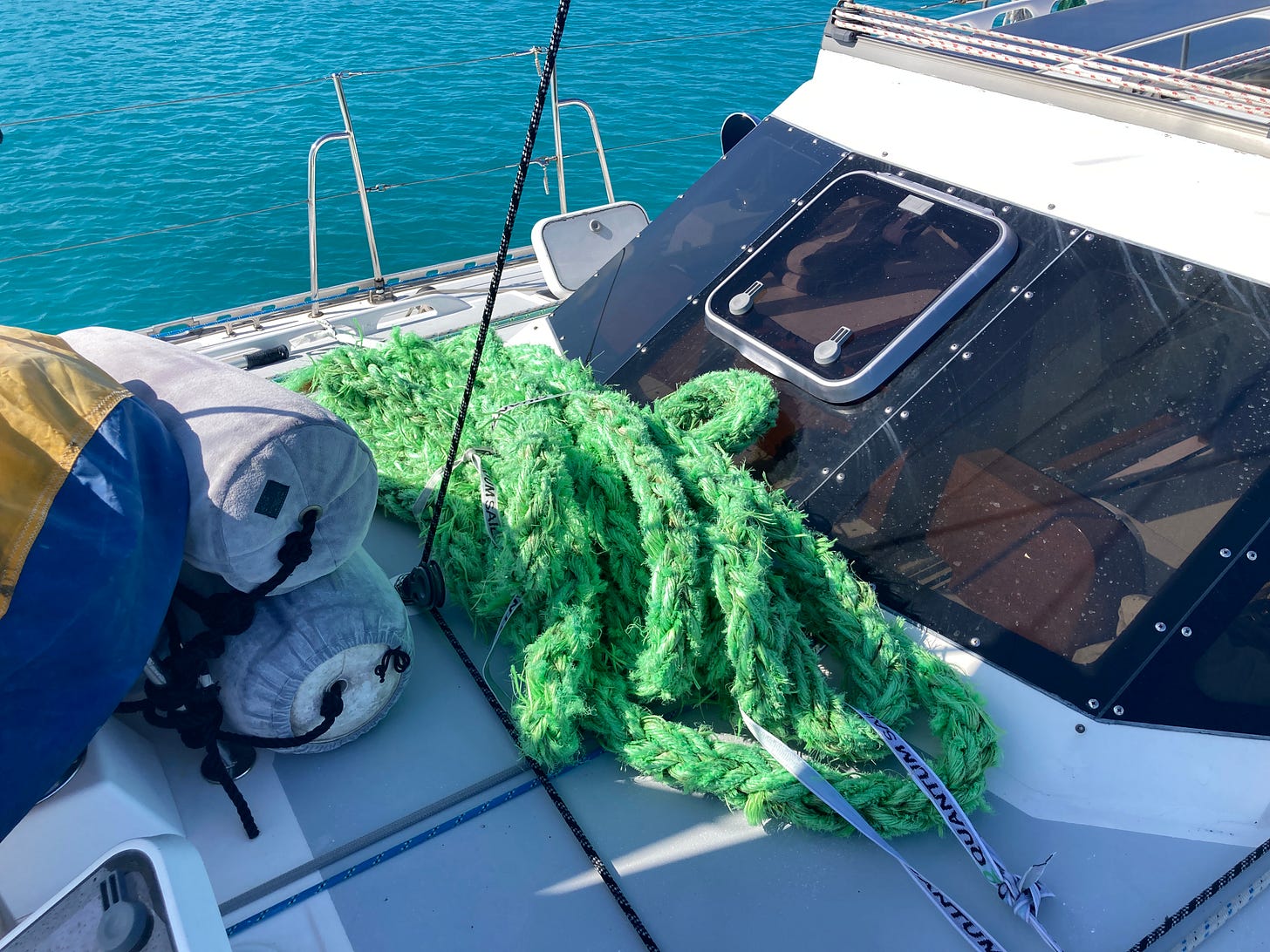A winter in the Caribbean is an excellent winter. Living aboard, and cruising in the sun and trade winds is a joy. Eventually, though, it is time to do something different. What Laughing Gull can do really well that is different is eat up ocean miles and transport a crew someplace entirely new. So that is what we did.
We left Tortola on a late-April Thursday, with Cormac and Choryna, two excellent Irish crew aboard. Destination was Bermuda, due north, and about 850 sea miles away. The forecast wasn’t ideal. Light winds for the first 500 miles or so, then upwind for the last 300 miles. Our PredictWind routing warned that we could be motoring for more than four (of 7) days, and suggested I make sure I had enough fuel aboard. But we were all itchy to move on, and have enough faith in LG both in light wind and upwind, to ignore the worst fears of the weather models.
Happily, there was plenty of good sailing in the first 500 miles, and in the end we had the engine on for a total of (only?) 40 hours. We had beautiful skies, starry nights, a sliver of bright moon, and Jupiter and Venus to watch over us. As long as we had 6-plus knots of wind on the beam or ahead of the beam, we sailed fine. It was a gentle way to ease into a passage, and Cormac, an excellent cook, fired up some amazing dinners and baked fresh bread. We even had some dolphin visitors.
Eventually, we hit the transition, just as predicted. The wind went light and died. We motored, and waited for the new wind to arrive. After about 12 hours a light breeze from the northwest started to tickle the sea surface, signalling the approach of a forecast front. We had to dodge a few messy squalls as it passed over us, but none hit us (in fact, we didn’t endure one direct hit from a squall during the passage, which felt lucky). Behind the squall line the wind quickly built and flicked into the northeast. We were now hard upwind, with a double reef in the main, looking at 300 miles to go in confused seas and winds that ranged between 17 and 23 knots.
There are many boats in which that would have been quite painful. Over the years I have sailed LG, though, I have learned that going upwind in those conditions can be perfectly tolerable. The hardtop keeps the watchstander warm and dry. LG is easily driven and doesn’t need too much sail to go fast in rough conditions. The world you live in usually tilts no more than about 15 degrees. Apart from some leaky hatches which squirted water on occasion it wasn’t so bad.
There is, however, one aspect of going upwind in LG in those conditions that I find trying. The first is that when LG slams into a trough after being lifted by a wave it is…LOUD. Louder than almost any boat I have ever sailed. It doesn’t seem so bad from the cockpit. But if you are trying to sleep down below it feels and sounds as if an angry sea god has slammed the hull with a giant sledgehammer. It really is a shocking impact. Sometimes it is hard not to groan in sympathy with the suffering of the hull and all the fittings holding the rig up.
Human helmspersons at full concentration can reduce the frequency of slamming. But in very confused seas it is virtually impossible to eliminate it. You just endure and hope all the designers and engineers have done their math correctly. Still, it is hard not to worry just a bit about breakage or rig failure. n the end, LG handled it all with aplomb. But still. That noise.
We had about 24 hours of hard breeze and hard(er) living. Shortly after the following sunrise, with lighter winds and milder sailing conditions finally in prospect, I looked astern and saw a long green trail. It couldn’t be phosphorescence, I unhappily realized. It could only be fishing gear (which helped explain why we seemed oddly slow at times overnight). I assumed it was a length of netting hooked on the rudder. But when I went down onto the transom to retrieve it with a boathook I discovered it was a heavy polypropylene warp. Worse, even after we retrieved the ends we couldn’t pull it clear under the boat. There was only one thing to do: heave to and get in the water. So that is what I did, with the wind still blowing hard and the boat heaving up and down.
I wore a harness and tethered myself to the stern. The water was brisk, but not painful. I could see clearly under the boat with a mask and snorkel, and it took perhaps 10 minutes to clear the warp and get it on deck. Even though LG was moving at only two knots, pulling myself back aboard was surprisingly difficult.
Once the Green Monster was coiled on deck—a final adversity dispatched—we were back to plain sailing. As we closed on Bermuda, the wind started to ease and the sailing crossed back into the Very Pleasant range. Even better, the wind direction stayed far enough east that we fetched the St. George’s sea buoy without having to tack. I think we spent less than an hour out of a 161 hour passage on port tack.
We made landfall shortly after dawn. We had been at sea just under 7 days, and traveled 910 miles at a relatively sedate average speed of 5.6 knots (LG had averaged 7.5 knots going the other way in November). Overall the passage had been so enjoyable that none of us had barn fever. We all felt as if we could stop for a quick shower and beer, and then keep going. That is a tribute to LG, and her passagemaking capability. My comfort and confidence in this boat only keeps growing.
Now we are hanging in beautiful St. George’s for a few weeks, before heading across the Atlantic to the Azores at the end of May. LG is in pretty good shape, though I still need to somehow stanch those hatch leaks. After all the miles sailed, the 2000 miles to Horta no longer seems like such a big leap to me. It occurs to me: A boat that shrinks oceans is a very good boat.
Anthropocene Notes:
LG wasn’t the only one making a move. While we were at sea, in northern Sweden the Great Moose Migration was underway (Love the concept of Slow TV):
Is using Chat GPT Climate Abuse? This is a question very close to my heart, and Hannah Ritchie says the answer is…no:
My sense is that a lot of climate-conscious people feel guilty about using ChatGPT. In fact it goes further: I think many people judge others for using it, because of the perceived environmental impact.
If I’m being honest, for a while I also felt a bit guilty about using AI. The common rule-of-thumb is that ChatGPT uses 10 times as much energy as a Google search [I think this is probably now too high, but more on that later]. How, then, do I justify the far more energy-hungry option? Maybe I should limit myself to only using LLMs when I would really benefit from the more in-depth answer.
But after looking at the data on individual use of LLMs, I have stopped worrying about it and I think you should too.
She goes on to explain (Hint: if you care about your personal climate footprint it is still all about diet, driving, flying and gas heating).
3. So true (Source):
If you liked this post from Sailing Into The Anthropocene, why not subscribe here (free!), and/or hit that share button below? You can also find me on Instagram and BlueSky.











Confidence in your vessel keeps you sane and I winced when you described that precipitous drop to windward. The forces are absolutely incredible. Enjoy Bermuda! ~J